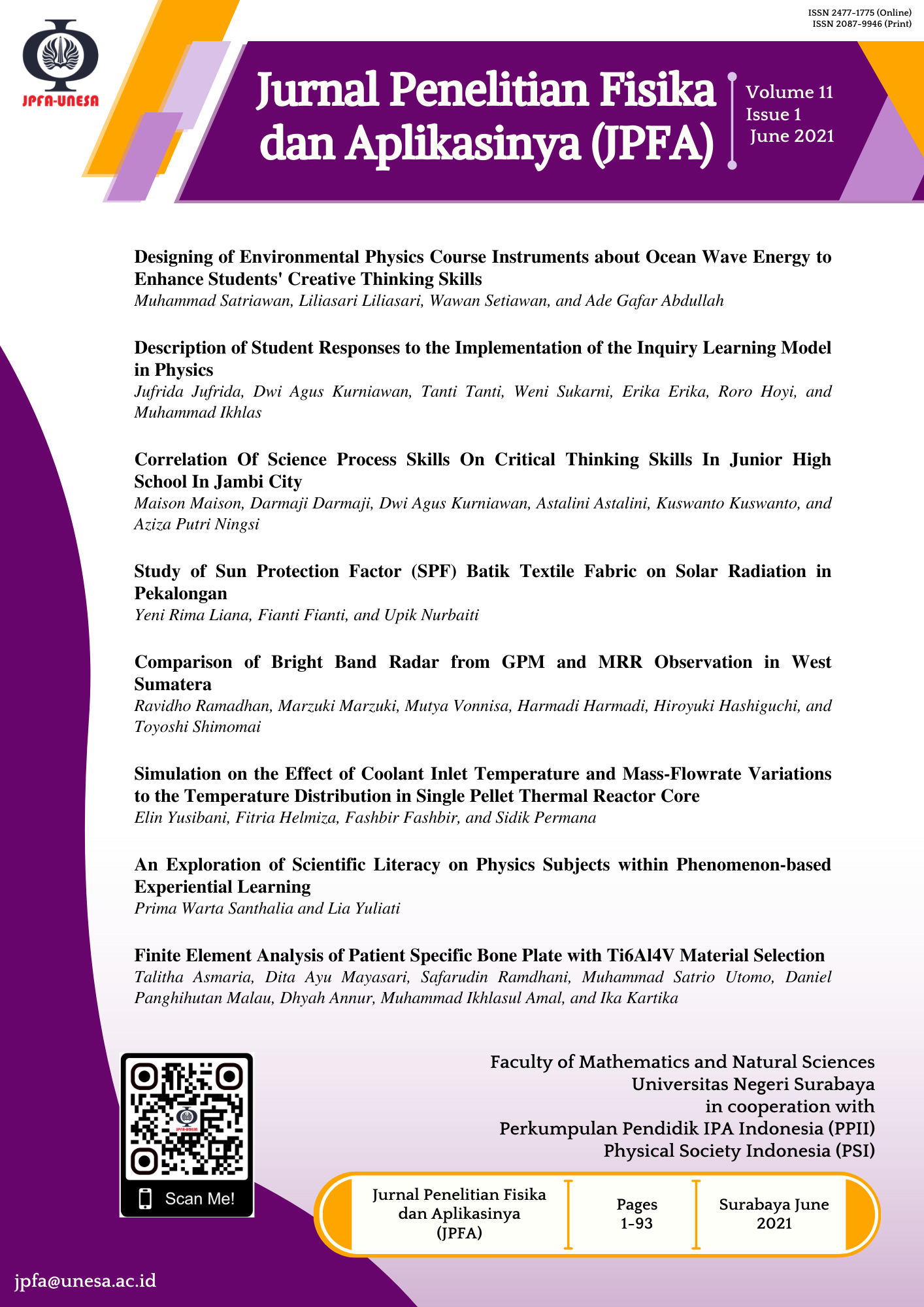Study of Sun Protection Factor (SPF) Batik Textile Fabric on Solar Radiation in Pekalongan
DOI:
https://doi.org/10.26740/jpfa.v11n1.p39-49Keywords:
SPF, intensity, batik textile fabricsAbstract
The amount of sunscreen ability is determined through the value of a person's Sun Protection Factor (SPF) when under the sun without experiencing sunburn. This study aims to measure the intensity of sunlight received by batik textile fabrics and SPF measurements to determine the ability of these fabrics to protect sunlight radiation. The research was conducted at the Sorogenen area in Pekalongan, Central Java. The intensity data collection is done during the sunny weather with 300C - 320C temperature. The SPF value is calculated by comparing the intensity of sunlight without and with a protective batik cloth. Between 10:00 a.m. and 2:00 p.m. (GMT +7), the average intensity is 85.160 lux to 113.400 lux. The results obtained by fabric with a thickness of 2 mm have an SPF greater than fabric with a thickness of 1 mm. Cotton fabric has the ability to protect against sunlight better than satin and Mori fabric. A blue cotton cloth owns the most significant SPF value with a thickness of 2 mm of 36.06. In comparison, the smallest SPF value is owned by yellow Mori fabric with a thickness of 1 mm of 5.24.
References
Sugiyana D, Septiani W, Mulyawan AS, and Wahyudi T. Development of Textile for Anti Ultraviolet Roof Through Application of ZnO Nanoparticle Using the Modified Padding Method. Jurnal Ilmiah Arena Tekstil. 2018; 33(2): 75-84. DOI: http://dx.doi.org/10.31266/at.v33i2.4270.
Arjun D, Kavitha A, and Hiranmayee J. Textile Materials Used for UV Protection. International Journal of Advance Research in Engineering and Technology. 2013; 4(7): 53-59. Available from: https://iaeme.com/Home/article_id/IJARET_04_07_007.
Hakim LM. Batik sebagai Warisan Budaya Bangsa dan Nation Brand Indonesia. Nation State: Journal of Intertnational Studies. 2018; 1(1): 61-69. DOI: https://doi.org/10.24076/NSJIS.2018v1i1.90.
Allen MW and Bain G. Measuring the UV Protection Factor of Fabric. 2008: 1-4. Available from: https://www.semanticscholar.org/paper/Measuring-the-UV-Protection-Factor-of-Fabrics-Allen-Bain/d588d0121f49007b83593c3a16372d5adb3e4be2.
Tantari S H W. Pakaian sebagai Pelindung Surya. Jurnal Kedokteran Brawijaya. 2003; 19(2): 1-7. DOI: http://dx.doi.org/10.21776/ub.jkb.2003.019.02.7.
Louris E, Sfiroera E, Priniotakis G, Makris R, Siemos H, Efthymiou C, and Assimakopoulos MN. Evaluating the Ultraviolet Protection Factor (UPF) of Various Knit Fabric Structures. IOP Conference Series: Materials Science and Engineering. 2018; 459: 012051. DOI: http://dx.doi.org/10.1088/1757-899X/459/1/012051.
Dobnik P. Wowen Fabric and Ultraviolet Protection. Woven Fabric Engineering. 2010; 273-296. DOI: http://dx.doi.org/10.5772/10467.
Downloads
Published
How to Cite
Issue
Section
License
Copyright (c) 2021 Jurnal Penelitian Fisika dan Aplikasinya (JPFA)

This work is licensed under a Creative Commons Attribution-NonCommercial 4.0 International License.
Author(s) who wish to publish with this journal should agree to the following terms:
- Author(s) retain copyright and grant the journal right of first publication with the work simultaneously licensed under a Creative Commons Attribution-Non Commercial 4.0 License (CC BY-NC) that allows others to share the work with an acknowledgement of the work's authorship and initial publication in this journal for noncommercial purposes.
- Author(s) are able to enter into separate, additional contractual arrangements for the non-exclusive distribution of the journal's published version of the work (e.g., post it to an institutional repository or publish it in a book), with an acknowledgement of its initial publication in this journal.
The publisher publish and distribute the Article with the copyright notice to the JPFA with the article license CC-BY-NC 4.0.
 Abstract views: 608
,
Abstract views: 608
, PDF Downloads: 632
PDF Downloads: 632









